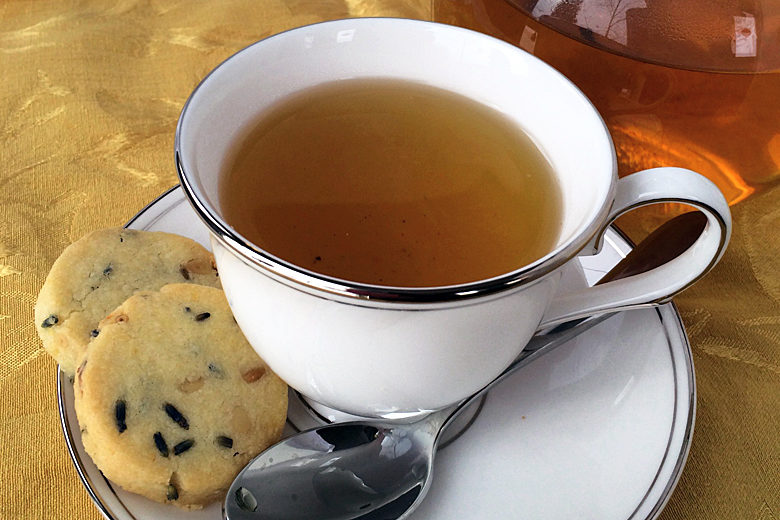
As I sit on my couch on this blustery cold day with a cup of tea, I am reminded of how it has the power to heal both body and soul. While I love coffee to get my mornings started, when I want to enjoy a hot afternoon beverage, relax in the evening, or heal a sore throat, I turn to tea.
Tea is naturally rich in antioxidants, thanks to flavonoids. Some of the proposed health benefits range from boosting the immune system to protecting against certain cancers and heart disease. Specifically, white tea may help prevent skin aging, has antiviral and antibacterial properties, and green tea contains fluoride. Tea can also be a smart beverage choice for hydration, as long as you choose one of the lower caffeine varieties.
Similar to a wine tasting, hosting a tea tasting with a small group of friends is a great way to compare different varietals and explore the range of aromas and flavors. In addition to sharing good company and conversation, everyone will likely walk away learning something new. Here are some tips to get you started:
1. There are several varieties of tea based on the amount of oxidation (fermentation). The longer a tea has been oxidized, the more caffeine it contains. Brewing time will also increase the amount of caffeine.
- White tea is the least processed with no oxidation and green tea is minimally oxidized.
- Oolong tea is oxidized for 2-3 hours.
- Black tea oxidizes for up to 4 hours.
2. For your tasting, I recommend five to six tea varieties to provide enough for comparison but not be overwhelming. You could ask each guest to bring one type of tea. Having a few tea kettles will also be helpful. For best results, choose loose leaf teas and brew in a tea diffuser, using filtered water.
3. As a general recommendation, use one teaspoon of tea for the pot or kettle and add an additional teaspoon for every cup of water used.
4. In general, white and green teas brew for 2-3 minutes and oolong, black and herbal teas brew for 4-5 minutes. If you're like me and prefer a stronger cup of tea, simply add more tea leaves to the diffuser and brew for the suggested amount of time. Increasing brewing time will only result in bitter tea.
5. For white and green tea, bring water just to a boil and allow to cool for a minute or two before pouring over tea leaves. For black, oolong and herbal teas, bring water to a rolling boil and pour over tea leaves immediately.
6. Brewed tea is known as “liquor.”
- Smelling the liquor: After draining the leaves, allow them to cool for a minute or two and then breathe in deeply to take in the aromas.
- Tasting the liquor: Just like with wine, to properly taste the liquor, you should slurp it instead of sipping. Don’t worry about being rude — this allows the tea to aerate in your mouth, releasing more of the aromas and flavors. Finish by swishing it around to expose the liquor to all of your taste buds before swallowing. If you’re concerned about taking in too much caffeine in one sitting, you can also choose to spit out the tea after tasting.
7. Taste the teas in order of strength, starting with the one with the most delicate flavor and ending with the boldest.
If you’d love to learn more about the specifics of tea, two great resources include The Tea Enthusiast’s Handbook, by Mary Lou Heiss and Robert J. Heiss, and The Harney & Sons Guide to Tea, by Michael Harney.
And, for something to serve with your tea, follow the recipe below.
Lavender Pine Nut Shortbread Cookies
Recipe developed by Olena Gudz Danko, MS, RD, LD
Makes 36-40 cookies
I love a good shortbread cookie, especially with a cup of tea. The rich, buttery dough is a blank canvas for many flavor combinations. Since some of my favorite tea blends include lavender, I created a cookie that captures its relaxing, floral essence. With some additional crunch from the pine nuts, one bite will transport you straight to the Mediterranean.
Ingredients
12 tablespoons (1 ½ sticks) unsalted butter, softened
2/3 cups granulated sugar
1 egg yolk
½ teaspoon pure vanilla extract
1 ¾ cups all-purpose flour
1/8 teaspoon salt
1/3 cup pine nuts
2 tablespoons dried culinary lavender flowers
Instructions
- Preheat oven to 375 degrees Fahrenheit.
- Toast pine nuts in a small skillet over medium-low heat until lightly golden and let cool.
- Cream together butter and sugar on medium speed in the bowl of a standing mixer fitted with paddle attachment. Add egg yolk and vanilla extract and continue beating until smooth. On the lowest speed, add the flour and salt, mixing until dough just comes together. Stir in the cooled pine nuts and lavender. The dough will look slightly dry and crumbly initially. Press the dough together between two pieces of wax or parchment paper and chill for at least one hour in the refrigerator.
- Place dough on a lightly floured surface and roll out to about 1/3-inch thickness. Cut circles using a 1 ¾-inch round cookie cutter.
- Place cookies one-inch apart on a baking sheet. Bake for 10 minutes, or until edges and tops are light brown. Cool for two minutes on baking sheet before transferring to a cooling rack. Store at room temperature in an airtight container.
Note: You can use larger cookie cutter rounds and end up with fewer cookies, if you prefer.







